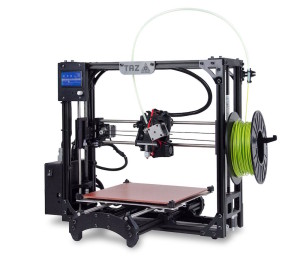
LulzBot TAZ 5 Desktop 3D Printer with 0.5 mm Nozzle
The Lulzbot TAZ 5 3D printer, prominent in Lulzbot’s flagship line of 3D printers, is intended to bring industrial printing to the desktop. Make magazine’s 3D Printer Review (Buyer’s Guide) named the new TAZ 5 as “Best Overall”, “Outstanding Open Source”, and “Best Large Format”. 3D Hubs in its LulzBot Taz 5 Review calls it an open source 3D printer for tinkerers.
The large open-framed TAZ 5 has a sturdy aluminum frame with with no door, top, or sides and measures (28.6H, 20.5W, 20.3D) inches. There is a correspondingly large print area (11.7H, 10.8W, 9.8D) inches, which is larger than that of the Ultimaker 2. The layer height or resolution ranges from a minimum of 75 microns up to 350 microns. The print bed and the extruder assembly are both mounted on motorized carriages, with the print bed moving in and out on the Y-axis, while the print head moves up and down on the Z-axis and side to side along the X-axis. The maximum print speed is 200 mmm per second. Updates to the new TAZ 5 version include a new hot end, a new sticky-when-hot print bed surface, and newly customized Cura open-source printer software.
Unlike its novice-friendly sibling, the Lulzbot Mini, the TAZ 5 comes partially assembled. There is a rather involved setup process (illustrated with photos) in the Quickstart guide that includes attaching the print bed, the extruder, the cable assemblies, the power supply, the filament guide, installing the Cura software, adjusting the Z-axis, leveling the print bed, attaching and loading the filament, and setting the temperatures on the hot end and the print bed. The printer comes with a handy bag of setup and adjustment tools, but note that the printer does not come with a spool of filament, so you’ll have to add that to your order to do any sustained printing. Included is a 1-m test filament, enough to print out an octopus test figure which you download from the LulzBot site.
The TAZ 5 should be placed where there’s room for its carriage movement and away from kids and pets who might come in contact with its hot, fast-moving parts. The TAZ 5 can produce very high quality prints in a wide range of materials. Lulzbot’s new Hexagon all metal metal hot end reaches temperatures up to 300C (572F) which will allow a multiplicity of 3-mm filament materials beyond the usual ABS, and PLA, including the recommended HIPS (high-impact polystyrene), polycarbonate, flexible filaments, and Nylon. The TAZ 5 ships with a 0.50-mm aperture nozzle that allows printing more plastic per layer and makes it easier to experiment with newer filaments containing powdered copper, bronze, iron, steel, and wood. However, the 0.35-mm nozzle is still available and will support finer resolution layers. Also available is a dual head extruder that allows you to use two different colors or materials on a print job, and is suitable for more expert users.
A new polyetherimide (PEI) print surface lies atop the heated borosilicate glass print bed, increasing adhesion and reducing warping issues without the need for supplemental adhesive tapes and films atop the print bed. The PEI adheres strongly to plastics such as ABS, PLA, and HIPS at the recommended temperatures, even resisting forcibly prying off, but allowing easy lifting off of your print once it’s cooled to room temperature. It’s also sturdy and resistant to the nicks, gouges, and peeling of the PET tape used on the TAZ 5’s predecessor TAZ 4.
The newly customized open source Cura LulzBot Edition is easy to use. Cura LulzBot Edition for Windows, OS X or Linux is downloadable from the LulzBot site, as are two other open source choices Printrun and Slic3r. Once it’s installed and opened, the Cura’s QuickPrint menu lets you set the print quality and choose between HIPS, ABS, and PLA filaments. Load Module will allow you to access any 3D-printable files on your computer for printing, and the Control button brings up the 3D printer control interface. Once the computer is connected to the printer via USB, it can heat the extruder and print bed to the correct temperatures for the job. The print file can also be saved to an SD card and loaded onto the 3D printer for untethered printing of multi-hour jobs.
PC Magazine, in its LulzBot TAZ 5 Review, cites Aleph Objects, the maker of LulzBot printers as supporting both Free Software and Open Source Hardware. This means you can freely adopt the latest technology from across the 3D printing industry to upgrade your equipment whenever you wish, as well as being supported by an enthusiastic LulzBot community.
Tom’s Guide in its 3D Printer Review calls the LulzBot TAZ 5 the filament 3D printer to beat. It’s excellent for serious users wanting high speed, high volume, and high print quality in a wide variety of materials.
Be sure to check out our LulzBot TAZ 6 review as well as the LulzBot mini review.
Do you use the LulzBot TAZ 5 3D Printer? Please comment and let the community know your thoughts, rating, or review.

Pingback: LulzBot TAZ 6 3D Printer Review - 3D Engineer